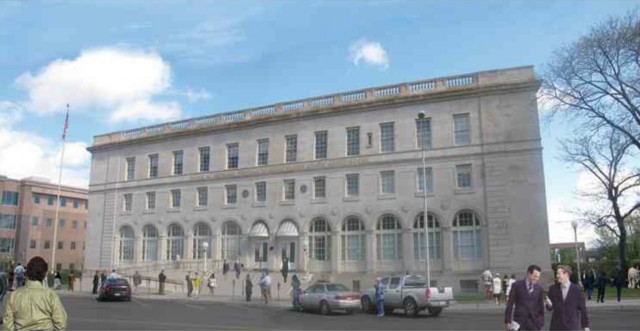
Earlier this week (Wednesday, February 20), GSA rededicated the 95-year-old, 41,562-square-foot Wayne N. Aspinall Federal Building and U.S. Courthouse in Grand Junction, Colo., after 23 months of construction that addressed the dual challenges of historic preservation and sustainability. The goal of this $15 million American Recovery and Reinvestment Act (ARRA) project was to make it GSA’s first net-zero energy building—that is, a structure that produces as much energy as it consumes—on the National Register of Historic Places.
The three-story Second Renaissance Revival building at 400 Rood Avenue in downtown Grand Junction was designed by James A. Wetmore and constructed between 1915 and 1918. Originally known as the Grand Junction Post Office and U.S Courthouse, it was expanded in 1939 with funding from the Works Project Administration (WPA). In 1972, it was renamed after Congressman Wayne Aspinall, who represented Colorado’s Fourth District for more than 30 years. It was listed on the National Register of Historic Places in 1980. The structure now houses offices for nine federal agencies, including the Federal Bureau of Investigations, Internal Revenue Service, U.S. Army Corps of Engineers and U.S. Attorneys.
Designed to achieve LEED-Platinum certification, the modernization project involved the use of a wide range of advanced systems, including the installation of 385 rooftop photovoltaic solar panels, a geothermal heating and cooling system, highly efficient lighting systems, increased insulation of the building envelope and state-of-the-art metering and building controls. In addition to transforming the structure into a high-performing green building, the project also brought many of the structure’s original historic features back to life. The main lobby—which had been reduced to a small entry vestibule—was restored to its original grandeur by exposing the original arched windows, decorative column capitals, a marble-bordered terrazzo floor and other historic elements, and a three-story-high historic curved stairwell that had been hidden behind a wall was reopened.
Want to learn more about GSA’s stimulus spending projects? Click our “Stimulus” link in the column to the right to see some of the other projects where GSA is spending its $5.5 billion in ARRA funds.
